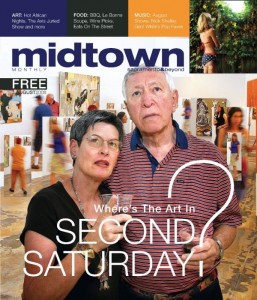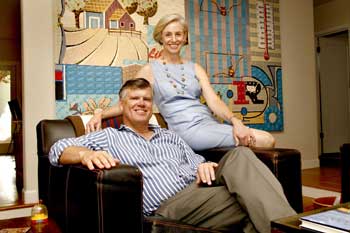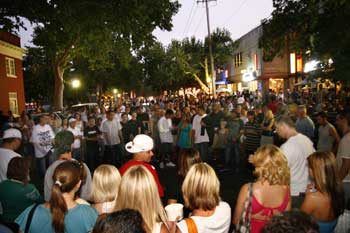How Sweet It Is?
Posted on August 18, 2008 – 7:12 PM | by livmoe Picture this: it’s the second Saturday of the month and you’re in Midtown. The streets are alive with people eating, shopping, drinking and visiting galleries. A quick ten-block stroll might take you 30 minutes or more to complete because of the sheer mass of bodies on the street and suddenly you wonder to yourself, ‘can this really be Sacramento?’
Picture this: it’s the second Saturday of the month and you’re in Midtown. The streets are alive with people eating, shopping, drinking and visiting galleries. A quick ten-block stroll might take you 30 minutes or more to complete because of the sheer mass of bodies on the street and suddenly you wonder to yourself, ‘can this really be Sacramento?’
Let’s begin at the beginning shall we? In the early ‘90s, after many trips both national and international, the late Michael Himovitz, along with his partner Chuck Miller identified a deficiency in the Sacramento art scene. Himovitz, the owner and founder of the gallery that bore his name, and Miller, his collaborator and life partner of close to ten years determined that like Paris, Seattle, and Los Angeles, Sacramento needed a communal reception night for art galleries. By 1992, Second Saturday was born.
Originating in a variety of locations throughout the region, Second Saturday took place everywhere from North Sac, to Arden, to Downtown, and many other locations in between. In the early days of the event without one central location – although even at this early stage the concentration of galleries seemed to mostly exist Downtown – art goers had to select their route based on artist and gallery. “We had collectors coming all the way from San Francisco and spending the night to go to receptions,” reflected Miller.
In 1994 Miller, Rob and Tracy Kerth, Bob Slobe, and Kim Mueller  introduced the Phantom Galleries concept as a companion piece to the burgeoning artwalk. Designed to utilize abandoned properties along Del Paso Boulevard, Phantom Galleries created shows for artists by artists for one night only every month. Unlike Second Saturday proper, Phantom Galleries gave a venue to first timers and pre-emerging artists who weren’t ready for the established gallery scene. In addition to giving up-and-comers a chance, the program was also an opportunity for area business owners to get foot traffic in their vacant properties. “Dan Friedlander [Limn], Charles Sumner and Glen Sorenson all bought as a result of Phantom Galleries,” said Kerth over a recent breakfast at Lil’ Joe’s.
introduced the Phantom Galleries concept as a companion piece to the burgeoning artwalk. Designed to utilize abandoned properties along Del Paso Boulevard, Phantom Galleries created shows for artists by artists for one night only every month. Unlike Second Saturday proper, Phantom Galleries gave a venue to first timers and pre-emerging artists who weren’t ready for the established gallery scene. In addition to giving up-and-comers a chance, the program was also an opportunity for area business owners to get foot traffic in their vacant properties. “Dan Friedlander [Limn], Charles Sumner and Glen Sorenson all bought as a result of Phantom Galleries,” said Kerth over a recent breakfast at Lil’ Joe’s.
The intention of Phantom Galleries wasn’t just to expose commercial properties to developers, however. Those involved in the early planning stages of the event hoped that in time artists would be able to permanently inhabit some of the spaces that were rehabbed for the Phantom Galleries project. As an extension of this the North Sacramento Chamber, in conjunction with SHRA, tried to create an artist live-work program that would enable artists to inhabit commercial buildings. “A vision for all of us was that the artists could maintain a say, so that if the area gentrified the artists wouldn’t be pushed out,” says Mueller. Unfortunately, the artist live-work project never fully caught on, with only one artist actually making use of the program, at one time inhabiting the commercial building that now houses the Sacramento Metropolitan Arts Commission (SMAC).
 In time, Phantom Galleries was nicknamed Second Shift because the event took place later in the evening so as not to compete with the more established art spaces. Together, Second Saturday and Second Shift created a synergistic, monthly event enabling artists, patrons, and gallerists to see, exhibit, and consume art in ways never before seen in the area. “There was just all of this great energy,” said Slobe, “we really wanted it all to happen for the arts community.”
In time, Phantom Galleries was nicknamed Second Shift because the event took place later in the evening so as not to compete with the more established art spaces. Together, Second Saturday and Second Shift created a synergistic, monthly event enabling artists, patrons, and gallerists to see, exhibit, and consume art in ways never before seen in the area. “There was just all of this great energy,” said Slobe, “we really wanted it all to happen for the arts community.”
With the lure of redevelopment dollars, and encouraged by the arts community he helped nurture, Miller purchased a building on Del Paso Boulevard with the hopes of creating an art complex that could house the Himovitz Gallery. The project ran into troubles, however, both from the city and from some of his initial tenants, one of whom backed out before the building was ready to occupy.
Almost immediately following the completion of the project, the Del Paso bubble began to burst. By the time Miller closed the complex in 2001, the Phantom Galleries project had wound down to its current state of only one functioning location, at 920 Del Paso Boulevard. Post-Himovitz, the Horse Cow art complex was asked to relocate, and most recently the area has suffered the loss of Sol Collective to a fire.
As the once thriving Del Paso art region took a series of hits, Midtown began its steady rise not just in relation to the arts but to commerce in general. Trendy restaurants, wine bars, boutiques, and night clubs started to spring up like dandelions laying the infrastructure for an art scene to erupt. “Midtown has better bones for creating an art community because it’s just so darn compact,” says Kerth.
Talking with Miller in his tidy living room about the past twenty-plus years of Sacramento art history was quite an education. A slender, soft-spoken man, Miller spoke carefully about his time spent in the local art scene. What was perhaps the most noteworthy about our discussion was the fact that Miller no longer patronizes the event he helped to invent which raises some stark questions about where Second Saturday is now and where it is, or should be, going.
“Downtown has benefited so much from Second Saturday and the artists haven’t benefited from it at all really,” says Ianna Frisby, co-owner and resident artist at the Tangent Gallery. Frisby’s sentiment is one that’s been heard frequently in recent months and is perhaps best illustrated by Sac Bee reporter Rick Kushman’s comment in his recent article on Second Saturday: “On this last walk I didn’t get within 50 yards of a gallery.” While Kushman’s statement is somewhat tongue in cheek it makes a valuable point. At its core Second Saturday was founded around art, but has it stayed true to that aim? Some say yes and some say no.
“I think Second Saturday is a zoo right now. People are going out to get drunk and make the scene.” Says Slobe. “If you think about Second Saturday and the fact that there are gallery openings for these artists. If it’s too zoo-y you can’t really introduce artists to anyone. You can’t really represent the work.”
 One could easily agree with Slobe’s observations after a short stroll through the galleries clustered around 20th and J streets. On the average artwalk night, many galleries seem more like packed sardine cans than actual art spaces. Despite the frenetic nature of what’s currently going on in these galleries, work is actually selling. “I do sell on Second Saturday,” says Barry Sakata owner of the b. sakata garo gallery located on 20th street. In fact, unlike many area galleries which have an additional, more private reception for the artist, Sakata’s only monthly reception takes place on the night of the artwalk.
One could easily agree with Slobe’s observations after a short stroll through the galleries clustered around 20th and J streets. On the average artwalk night, many galleries seem more like packed sardine cans than actual art spaces. Despite the frenetic nature of what’s currently going on in these galleries, work is actually selling. “I do sell on Second Saturday,” says Barry Sakata owner of the b. sakata garo gallery located on 20th street. In fact, unlike many area galleries which have an additional, more private reception for the artist, Sakata’s only monthly reception takes place on the night of the artwalk.
Shirley Dubnick, owner of the Solomon Dubnick Gallery, which recently relocated to inhabit the new Marrs project on 20th Street, echoes Sakata’s claim. “Not only do we sell on Second Sat, but we get people who come back after that night when there is less of a crowd and buy.” Estimating that she gets around 2000 bodies through her space over the course of three or four hours. That kind of foot traffic won’t necessarily be bad for business.
In the past year, however, in response to police pressure and a desire to not contribute to what some have come to see as a grand scale cheap party, many spaces have stopped serving wine and food. According to Dubnick, the lack of booze hasn’t slowed attendance any. “We don’t serve any wine anymore, which surprisingly hasn’t limited the crowd.”
Brian Fischer, chair of the newly formed Midtown Business Association’s Second Saturday Task Force, [full disclosure: he’s also Midtown Monthly’s Director of Business Development –ed.] is all about the crowd. “It was pretty much unanimous amongst the board that Second Saturday is successful, and that we want to make sure that it continues to grow and evolve and that it doesn’t implode.” The Second Saturday Task Force was formed last April as swelling crowds became a concern for the city.
In addition to his work with the MBA, Fischer is also a part owner of the Midtown Grid, which works to provide central city small businesses with a greater level of exposure. Viewing the crowds and the revenue they bring as essential both to the Midtown region as well as the art community, Fischer saw the need to bridge communication between event organizers, businesses, restaurants, and galleries through the task force. “We would have not had a reinvigorated urban core within a 16 year period of time without Second Saturday,” says Fischer.
The organization of a Second Saturday task force could not have come at a better time. As the success of Second Saturday continues to build many have already expressed concerns that, much like the popular Thursday night market, the artwalk is doomed to become a victim of its own success. One gallery owner who asked to remain off the record, felt positive that with all of these bodies on the street drinking, it wouldn’t be long before someone gets hurt.
On a recent Second Saturday business was booming in the central city, restaurants were full many with a wait, and cash registers were steadily ringing. Whatever, the focus may now be for the artwalk, this is something to consider. While many parts of the country are feeling the crunch from the current recession (or non-recession depending on which radio station you choose to listen to) our little community appears to be thriving thanks to art. It is for this reason that no matter what the focus maybe today it is clear that the event is good for the economic health of our region.
If, like Del Paso almost a decade earlier, the Midtown bubble was to pop, what about the artists for whom this event is built around? While the early stages of the now-gargantuan gathering had a humble start, instigated by a small group of dedicated individuals who were steadfastly devoted to art, the current state of affairs seems decidedly more commerce-oriented. The conclusion of the Phantom Galleries project left some artists with long term studio space and also helped guide the Surrealestates projects through its long and winding road to success. When one examines the Midtown model these same long-term goals are more difficult to find.
When asked what he sees for the future of Second Saturday in Midtown as it relates to artists, Kerth returned a question with a question. “When does the brain trust of the art community meet?” asked Kerth. “I think it’s time for artists to think about where they are right now and where they want to be in five years or ten years or 20 years. What we need is the art community and its friends and other far thinking people to say to the city here’s the road map for the arts in the Sacramento region and here’s what you need to do this year to help us make that happen.”
Area artists have been lucky to have received early support from the likes of Slobe, Mueller, Himovitz, Miller and the Kerths, individuals who truly wanted to see our local talent supported and nurtured. Having been given this initial jumpstart, it may be time as Kerth suggests, for the artists themselves to take the wheel and drive.
Thanks to Chuck Miller (and his devoted team of interns), twenty years of Sacramento art history can now be found at the Sacramento Archives and Museum Collection Center. To see Miller’s collection and to find more information about the history of Sacramento art and Second Saturday go to www.cityofsacramento.org/ccl/history/index.html
Tags: Art Walk, Liv Moe, Midtown, Second Saturday



2 Trackback(s)